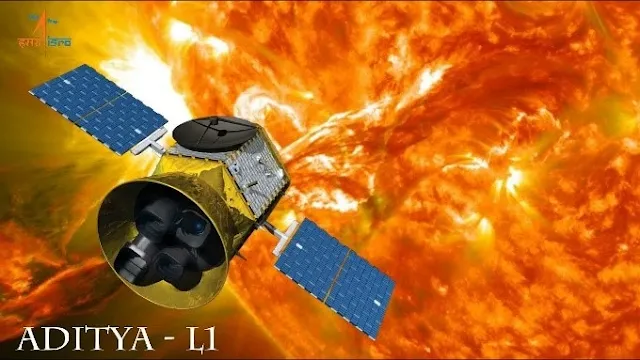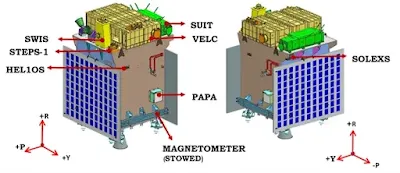Aditya-L1: India's New Star in Space, Chasing the Sun's Secrets
 |
Aditya-L1: India's New Star in Space, Chasing the Sun's Secrets |
The universe has always held an irresistible allure, captivating the imaginations of scientists, astronomers, and space enthusiasts alike. Among the countless celestial bodies that grace our skies, none is as vital and enigmatic as the Sun. It is the source of all life on Earth, a blazing ball of plasma that fuels our planet from millions of miles away. To explore and understand the Sun's complexities, the Indian Space Research Organisation (ISRO) embarked on a groundbreaking mission called Aditya-L1.
In this blog, we will embark on a cosmic journey to discover Aditya-L1, India's mission to study the Sun, its objectives, significance, and the incredible technological advancements it promises to bring to the world of space exploration.
Aditya-L1: A Glimpse into the Sun
Launched by ISRO, the Aditya-L1 mission is a testament to India's prowess in space science and technology. Named after the Hindu sun god 'Aditya,' this remarkable satellite seeks to explore the Sun as no mission has before. Positioned in a halo orbit around the first Lagrange point (L1), which is about 1.5 million kilometers away from Earth, Aditya-L1 is designed to observe the Sun continuously without being blocked by our planet's shadow.
Scientific Objectives
Aditya-L1 is equipped with a suite of scientific instruments designed to achieve a multitude of objectives, shedding light on some of the Sun's most profound mysteries:
1. Understanding Solar Dynamics: One of the primary goals of Aditya-L1 is to study the Sun's outermost layer, called the corona. The corona is incredibly hot, much hotter than the Sun's surface, and this paradox has puzzled scientists for decades. Aditya-L1 aims to analyze the dynamics of the corona and explore the mechanisms behind its extreme temperatures.
2. Solar Activity Prediction: The Sun is known for its unpredictable bursts of solar flares, which can disrupt communication systems and even pose threats to spacecraft and astronauts. Aditya-L1's instruments will provide crucial data for predicting solar activity, helping us prepare for and mitigate the impacts of solar storms.
3. Helioseismology: Aditya-L1 carries instruments for helioseismology, a technique that studies solar oscillations to gain insights into the Sun's internal structure and composition. This research could enhance our understanding of the Sun's lifecycle and evolution.
4. Magnetic Field Studies: The Sun's magnetic field is responsible for many solar phenomena, including sunspots, solar flares, and the solar wind. Aditya-L1 aims to measure the Sun's magnetic field and its variations over time, contributing to our knowledge of space weather.
Significance of Aditya-L1
Aditya-L1 is poised to make significant contributions to both solar science and space weather forecasting. Here's why this mission is of paramount importance:
1. Advancing Solar Physics: The data gathered by Aditya-L1 will revolutionize our understanding of the Sun's behavior, helping us unlock its deepest secrets. This knowledge can have far-reaching implications for various fields of science, from astrophysics to climate science.
2. Space Weather Forecasting: Solar flares and coronal mass ejections can have severe impacts on Earth's technological infrastructure, disrupting communication systems, power grids, and even satellite operations. Aditya-L1's data will enable us to predict these solar events with greater accuracy, providing valuable time for precautionary measures.
3. Global Collaboration: Aditya-L1's findings will contribute to international efforts in space science and solar research. Collaborative research in this field is crucial, as solar phenomena can affect countries worldwide.
Technological Marvels on Board
Aditya-L1 boasts a suite of cutting-edge instruments designed to capture unprecedented data about the Sun. Some of these instruments include:
1. Visible Emission Line Coronagraph (VELC): VELC will capture images of the Sun's outer atmosphere in various wavelengths, helping scientists analyze the temperature and velocity of coronal structures.
2. Multi-Application Solar Telescope (MAST): MAST will provide high-resolution images of the Sun's surface and the chromosphere, a region just above the surface, aiding in the study of solar flares and magnetic fields.
3. Plasma Analyser Package for Aditya (PAPA): PAPA will measure the composition and distribution of ions and electrons in the Sun's outer atmosphere, offering insights into the dynamics of the solar corona.
4. Solar Ultraviolet Imaging Telescope (SUIT): SUIT will capture images of the Sun in the ultraviolet range, revealing the dynamics of the solar chromosphere and corona.
These instruments are a testament to the technological prowess of ISRO and its dedication to pushing the boundaries of space science.
Challenges and Future Prospects
Space missions are never without challenges, and Aditya-L1 is no exception. The harsh conditions near the Sun, including intense radiation and temperature extremes, pose significant obstacles. However, ISRO's experience and expertise, honed through numerous successful missions, equip them to tackle these challenges head-on.
The data gathered by Aditya-L1 will undoubtedly pave the way for future space exploration endeavors. It will provide critical insights into the Sun's behavior and its impact on our solar system. Furthermore, the technologies developed for this mission may find applications in other fields, such as remote sensing and Earth observation.
Conclusion: A Sunlit Future
Aditya-L1 represents India's unwavering commitment to scientific discovery and space exploration. By unlocking the secrets of the Sun, this mission promises to revolutionize our understanding of the cosmos and improve our ability to predict and manage space weather. It showcases ISRO's remarkable capabilities and reaffirms India's place in the global space community.
As Aditya-L1 embarks on its journey to the L1 point, it carries with it the hopes and aspirations of scientists and space enthusiasts worldwide. It reminds us that the universe is an ever-expanding canvas of mysteries waiting to be uncovered, and with each mission, humanity takes another step toward unraveling its cosmic secrets.
In the words of Carl Sagan, "The cosmos is within us. We are made of star-stuff. We are a way for the universe to know itself." Aditya-L1 is a beacon of human curiosity, a testament to our quest for knowledge, and a reminder that the universe's wonders are within our grasp, waiting to be explored and understood.

